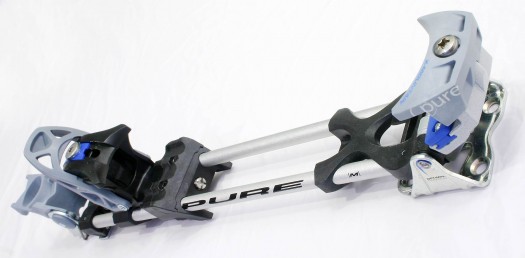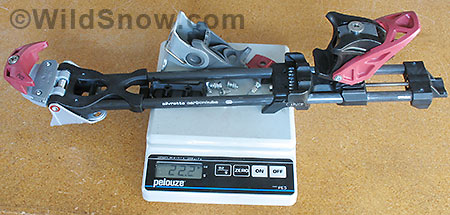Frequently Asked Questions (FAQ), tricks, and tips Silvretta Pure randonnee AT ski bindings.
Note: Silvretta Pure ski bindings have been discontinued, some appear to be available on used market and in retail backstock.
How to mount Silvretta Pure backcountry skiing bindings
First Look – 07/08 Silvretta Pure Freeride
Are Silvretta Pure Bindings durable enough?
How to shorten the Silvretta Pure.

Pure X-Mountain is a slightly more economical model in the Pure line. The Pure Freeride (not pictured) is top of the line, and features carbon rails to save weight. I liked the shiny aluminum of the X-Mountain rails for the photo, as they hearken back to days of the 300 model. Pure is easily the lightest randonee binding offering full step-in step-out in all modes, as well as safety release in all modes. Click image for massive enlargement.
What is the Silvretta Pure backcountry skiing binding?
A snow ski binding designed for backcountry skiing. It allows your heel to lift for walking and climbing, while providing a heel latch so you can ski downhill with the same turns you’d use with conventional alpine ski bindings. Pure’s main selling point is that it’s light in weight, yet allows the convenience of step-in step-out. The other lightweight contender, Dynafit, is not step-in (though it’s close).
Does the Pure come in different models?
Yes, four models. Listed below with weight and a brief description.
– Pure Freeride
Heavy duty, solid carbon frame rails, steel base, release adjusts to DIN 12.
Weight 07/08 model: 35.4 oz, 1002 gr (one binding weighed with with brake and screws, size medium).
– Pure X-Mountain
Intended as a compromise between weight/price/performance. Aluminum frame rails.
Weight 06/07 model: 29.4 oz, 844 g (one binding, weighed with no brakes, with screws, size medium)
– Pure Performance
Touring binding with lighter materials to reduce weight. Hollow carbon frame rails, alloy base. Only frame/plate binding available that competes with Dynafit in the weight arena.
Weight 06/07 model: 22.2 oz 628 g (one binding, no brakes, with screws, size medium)
– Pure Kidz
The only dedicated children’s AT binding on the market. The mechanicals and minimalist parts of the of the Pure binding line lend themselves to use by smaller/lighter individuals, thus making nice offering for youth are smaller folks. Goes down to boot sole length (BSL) 265 mm. Available from MEC.
(Brakes, wide version, weigh 3.4 oz, 96 g each)

Silvretta Pure backcountry skiing binding on the scale.
How does The Pure compare with Dynafit? The Dynafit Comfort binding model, for example, weighs 14.3 ounces (with screws), making the Pure Performance 6 ounces heavier per binding. That is a significant difference in the world of ultra-lightweight gear, and for backcountry skiers pounding huge vertical, but would make little real-world difference for the casual ski mountaineer. The Pure has a comfortable touring stride because the pivot is located closer to the ball of your foot, and it is very easy to enter and exit — both these factors save energy, thus compensating somewhat for the extra weight.
How does the Pure safety release work?
Don’t be embarrassed if you can’t figure out how the Pure side (lateral) release works. It’s indeed mysterious, and works like this: As your boot toe moves to the side, the boot is forced backwards by the toe encountering the curved portion of the toe jaws. This force moves the whole heel unit backwards on the binding rails, thus allowing the toe to continue to the side until a release is effected. It’s unknown how effective or prone to friction problems this release mechanism is, as the Pure has only been in production for a few years. The binding’s vertical release is similar to most other alpine and ski touring backcountry bindings.
I get ice in the Silvretta Pure heel latch, that makes it tough to change to downhill mode. Solution?
All backcountry ski bindings can have problems with ice and snow buildup. Keep all upper surfaces of your skis and bindings well coated with silicon, ski wax, or some kind of anti-wet compound. More, work some ski wax into the cavity where the end of the Pure binding plate latches when you switch to downhill (latched down) mode. In some situations it may be necessary to remove your skis and clean this area out by hand. When cleaning ice out of the cavity, don’t use an object that scratches (in other words, don’t use a knife or ski pole tip), once a surface is scratched ice will build up easier. Something like a popsicle stick works well for a cleaner.
Lou, come clean, do you recommend these things or not?
I have to admit to a bit of caution after the breakage we experienced during our Trooper Traverse backcountry skiing trip in 2006. Nonetheless, quite a few skiers are happy with their Pure bindings.
My take: If you are of average weight and not an aggressive skier, you’ll be satisfied with the Pure models. That said, the folks who make Pure bindings are quick to improve them from year to year. Thus, expect this binding to become more reliable in coming iterations.

